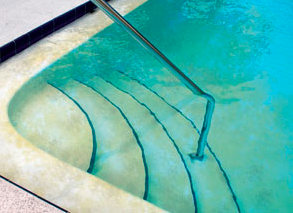Algae is not attractive.
Unfortunately, it loves swimming pools. And of course, algae always seems to bloom at the worst times. However, If you know what type of algae is infesting your pool, it can be very simple to kill it and prevent it from coming back again. We can also usually determine what caused the algae bloom to happen in the first place so that you can take preventative measures to keep your pool perfectly clear in the future. Some types of algae can be very stubborn, so we will talk about each type and the most effective way of getting rid of the unsightly growth in your pool once and for all.


What is it?
Common “green” algae are microscopic, aquatic plant-like organisms and can be free-floating or wall clinging. Algae grow in salt or fresh water and thrive in temperatures above 85°F. In fact, it can “bloom” overnight. Algae spores constantly enter the pool by rain, wind, animals, toys, or swimsuits and left unchecked, can clog filters and create surface damage.
To kill green algae:
- Use Algae Complete® as it kills all types of swimming pool algae
5 steps to prevent algae growth:
- Maintain a sanitizer residual of 1-3ppm
- Do an initial and weekly application of a preventative algicide (such as Algae Complete®)
- Shock routinely
- Make sure there is adequate circulation and filtration
- Brushing surfaces is vital


What is it?
Mustard algae is a chlorine-resistant form of green algae that often resembles dirt or sand on the bottom or sides of the pool. It contains compounds that act as a defense mechanism against the oxidation efforts of sanitizers, helping it survive even in highly chlorinated conditions. This factor can even create a large chlorine demand in certain situations. Mustard algae can be brushed away very easily but returns quickly.
To kill mustard algae:
- Use Algae Complete® as it kills all types of swimming pool algae
5 steps to prevent algae growth:
- Maintain a sanitizer residual of 1-3ppm
- Do an initial and weekly application of a preventative algicide (such as Algae Complete®)
- Shock routinely
- Make sure there is adequate circulation and filtration
- Brushing surfaces is vital


What is it?
Black algae are single-celled organisms that grow in large colonies. They contain chlorophyll like other algae, but they also contain compounds that mask the green color. It forms in cracks and crevices on pool surfaces (especially plaster finishes) and can grow somewhat protected from the surrounding environment due to the formation of a protective layer on the outside of the cell. This makes black algae more difficult to treat and it is somewhat resistant to normal chlorine levels.
To kill black algae:
- Use Algae Complete® as it kills all types of swimming pool algae
- Spot Kill® is specifically formulated to kill black algae on walls
- Spot Kill® WP should only be used on white plaster pools.
IMPORTANT NOTE: Brushing is extremely important when treating black algae because that protective layer has to be broken in order for the sanitizer or algicide to come in contact with the cells.
5 steps to prevent algae growth:
- Maintain a sanitizer residual of 1-3ppm
- Do an initial and weekly application of a preventative algicide (such as Algae Complete®)
- Shock routinely
- Make sure there is adequate circulation and filtration
- Brushing surfaces is vital
When you are struggling with an algae bloom of any kind, bring a water sample in for a FREE BioGuard water analysis and detailed instructions on how to remove the algae. Have as much information with you as possible, including the color, what happens when you brush it, if it comes back to the same place the following day, and where it is growing. Pictures are helpful as well. The most common places to find algae are on the steps and behind ladders; where there is little circulation. Make sure to brush these areas regularly.



